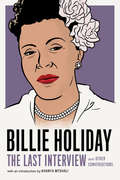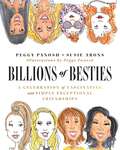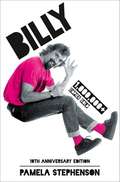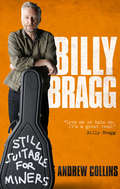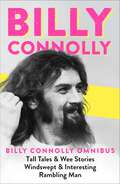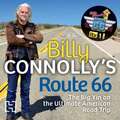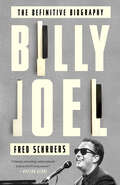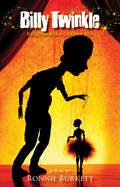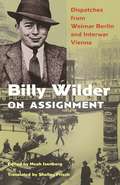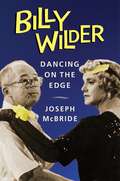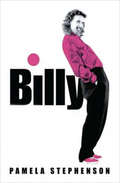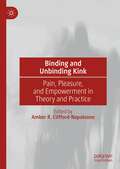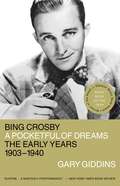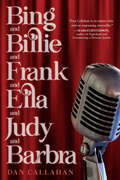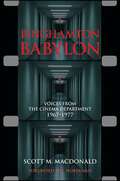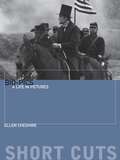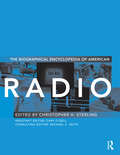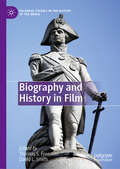- Table View
- List View
Billie Holiday: and Other Conversations (The Last Interview Series)
by Billie HolidayThe first-ever collection of interviews with the tortured but groundbreaking singer Billie Holiday, part of Melville House’s beloved Last Interview series Legendary singer Billie Holiday comes alive in this first-ever collection of interviews from throughout her career. Included is her last interview, given from her deathbed in a New York City hospital, where police were standing by ready to arrest her for a parole violation should she recover. Also included: The transcript of an interrogation by a US Customs official questioning about whether she'd violated her parole by using drugs on a foreign tour. But the book is more than a look at just the famously tragic side of her life. In other conversations, drawn from music magazines, late-night radio programs, and newspapers across the US and Canada, she discusses her childhood, musicians who influenced her, her friendship -- and falling out -- with the influential sax player Lester Young, why she chose the gardenia as her symbol, why she quit Count Basie's band, her substance abuse problems, writing songs and whether she wrote her own memoir, and more. In frank and open conversations, Billie Holiday proves herself far more articulate, aware, intelligent, and even heroic than the way she's often portrayed. This collection is an essential volume for all who have been moved by her music.
Billions of Besties: A Celebration of Fascinating and Simply Exceptional Friendships
by Peggy Panosh Susie AronsThis beautifully illustrated and joyful tribute celebrates famous friendships (both real and fictional) and proves that there is no relationship more important than friendship. Our best friends are our soulmates. They understand us when no one else does, lift us up, and bring out the best in us. It&’s a relationship based on a bond that can&’t always be described, but is always magical. Billions of Besties shines a light on some of the most engaging, funny, inspiring, and sometimes unexpected sets of friends. In this gorgeous and playfully illustrated volume, creators and besties Peggy and Susie highlight more than 100 besties, both real and fictional, from all walks of life. From the comedic powerhouse of Amy Poehler and Tina Fey, to the unexpected camaraderie between RGB and Antonin Scalia, the glamourous friendship between Anna Wintour and Roger Federer, or the fictional ride-or-die bond between Thelma and Louise, this book is a timeless salute to friendship in all its forms. Uplifting and charming, Billions of Besties celebrates the power and vitality of friendship—from bromances to work wives—reminding us that when we have each other&’s backs, we have the power to change the world.
Billy
by Pamela StephensonBilly Connolly has worked his way to the top from his working class roots. Billy has proved beyond doubt his versatility and sheer determination. Pamela writes about him - a highly talented musician, actor and comedian.
Billy Bragg: Still Suitable for Miners
by Andrew Collins'Love me or hate me. It's a great read’ - Billy Bragg He was a punk. He was a soldier. He was a flag-waver for the Labour Party and the miners. He is Billy Bragg, passionate protest folk singer and tireless promoter of political and humanitarian causes around the world. His life encapsulates so much about his generation: born in the late ’50s, passions forged by punk, politics shaped by Thatcherism, career inspired by engagement, hope provided by the end of the Cold War and ideology galvanised by what he sees as a ‘post-ideological’ twenty-first century. He adapts to survive: serious about compassion and accountability, he likes a laugh too, and has never forgotten where he comes from.Still Suitable for Miners is the official Billy Bragg story, tracing his life, family and career at close range from Barking to the present day. This 20th anniversary edition has been updated to include the rise of Corbyn, the unfolding of Brexit, Billy’s reclamation of skiffle and his overtures into Americana.
Billy Connolly Omnibus: Tall Tales and Wee Stories/Windswept & Interesting/Rambling Man
by Billy ConnollyTHREE TIMES THE LAUGHS: THE BEST OF BILLY CONNOLLY! 'Our greatest living comedian' Daily Mail'One of stand-up's great naturals. No one told a story better.' Guardian 'Furious, funny and foul mouthed' Sunday TimesTall Tales & Wee StoriesA collection of the very best of Billy's most famous routines including The Last Supper, Jojoba Shampoo, Incontinence Pants and Shouting at Wildebeest. With an introduction and original illustrations by Billy throughout, it is an inspirational, energetic and riotously funny read, and a fitting celebration of our greatest ever comedian.Windswept & Interesting 'It's the first time I've done this. Other people have written about me - or for me - but this time it's just my own life in my own words'Billy's joyfully funny, frank and full autobiography - stuffed full of hard-earned wisdom as well as countless digressions on fishing, farting and the joys of dancing naked. It is an unforgettable, life-affirming story of a true comedy legend.Rambling ManBilly's unconventional travel memoir that criss-crosses the world, encapsulating a lifetime of incredible journeys and hundreds of fascinating encounters - from riding his trike down America's famous Route 66, building an igloo on an iceberg in the Arctic, playing elephant polo (badly) in Nepal and crashing his motorbike (more than once), to eating witchetty grubs in Australia, being serenaded by a penguin in New Zealand, and swapping secrets in a traditional Sweat Lodge ritual in Canada.
Billy Connolly Omnibus: Tall Tales and Wee Stories/Windswept & Interesting/Rambling Man
by Billy ConnollyTHREE TIMES THE LAUGHS: THE BEST OF BILLY CONNOLLY! 'Our greatest living comedian' Daily Mail'One of stand-up's great naturals. No one told a story better.' Guardian 'Furious, funny and foul mouthed' Sunday TimesTall Tales & Wee StoriesA collection of the very best of Billy's most famous routines including The Last Supper, Jojoba Shampoo, Incontinence Pants and Shouting at Wildebeest. With an introduction and original illustrations by Billy throughout, it is an inspirational, energetic and riotously funny read, and a fitting celebration of our greatest ever comedian.Windswept & Interesting 'It's the first time I've done this. Other people have written about me - or for me - but this time it's just my own life in my own words'Billy's joyfully funny, frank and full autobiography - stuffed full of hard-earned wisdom as well as countless digressions on fishing, farting and the joys of dancing naked. It is an unforgettable, life-affirming story of a true comedy legend.Rambling ManBilly's unconventional travel memoir that criss-crosses the world, encapsulating a lifetime of incredible journeys and hundreds of fascinating encounters - from riding his trike down America's famous Route 66, building an igloo on an iceberg in the Arctic, playing elephant polo (badly) in Nepal and crashing his motorbike (more than once), to eating witchetty grubs in Australia, being serenaded by a penguin in New Zealand, and swapping secrets in a traditional Sweat Lodge ritual in Canada.
Billy Connolly's Route 66: The Big Yin on the Ultimate American Road Trip
by Billy ConnollyFollow much-loved Scottish comedian and bestselling author Billy Connolly across Route 66, on this unforgettable journey filled with music, modern history and hilarious stories.Billy Connolly first dreamed of taking a trip on the legendary Route 66 when he heard Chuck Berry belting out one of the greatest rock 'n' roll records of all time - and now he's finally had the chance to do it. Travelling every one of its 2,278 miles on his custom-make motorbike, Billy's journey takes him past many of the best-known icons in the US: the Gateway Arch in St Louis, Monument Valley and the Grand Canyon, and the funky neon-lit gas stations and diners that once lined the route.Billy also has the chance to get to know the people who call it home, from Mervin the Amish carpenter, to fellow banjo enthusiast and obsessive instrument collector Rob, to Angel, one of the many people determined to keep the spirit of the Mother Road alive. Funny, touching and inspiring in equal measure, the tales he gathers on the way tell the story of modern America.With his unrivalled instinct for a good story, and the gregariousness that has made him a comedy legend, Billy Connolly is the ultimate guide to the ultimate road trip.
Billy Joel: The Definitive Biography
by Fred SchruersThe long-awaited, all-access biography of a music legendIn Billy Joel, acclaimed music journalist Fred Schruers draws upon more than one hundred hours of exclusive interviews with Joel to present an unprecedented look at the life, career, and legacy of the pint-sized kid from Long Island who became a rock icon.Exhibiting unparalleled intimate knowledge, Schruers chronicles Joel's rise to the top of the charts, from his working-class origins in Levittown and early days spent in boxing rings and sweaty clubs to his monumental success in the seventies and eighties. He also explores Joel's creative transformation in the nineties, his dream performance with Paul McCartney at Shea Stadium in 2008, and beyond.Along the way, Schruers reveals the stories behind all the key events and relationships--including Joel's high-profile marriages and legal battles--that defined his path to stardom and inspired his signature songs, such as "Piano Man," "Scenes from an Italian Restaurant," "New York State of Mind," and "She's Always a Woman." Throughout, he captures the spirit of a restless artist determined to break through by sharing, in his deeply personal lyrics, the dreams and heartbreaks of suburban American life.Comprehensive, vibrantly written, and filled with Joel's memories and reflections--as well as those of the family, friends, and band members who have formed his inner circle, including Christie Brinkley, Alexa Ray Joel, Jon Small, and Steve Cohen--this is the definitive account of a beloved rock star's epic American journey.
Billy Twinkle: Requiem for a Golden Boy
by Ronnie BurkettStanding at the edge of the ship, contemplating a watery demise, Billy is called back to reality when his dead mentor Sid Diamond appears as a handpuppet. Sid forces Billy to re-enact his life as a puppet show, rekindling the passion Billy once had for puppets, people, and the dream of a life that sparkles. For anyone stuck in the middle—mid-career, mid-love, mid-life—this requiem for a golden boy shines a little light on the wonder of youth meeting the wisdom of age.
Billy Wilder on Assignment: Dispatches from Weimar Berlin and Interwar Vienna
by Billy WilderAcclaimed film director Billy Wilder’s early writings—brilliantly translated into English for the first timeBefore Billy Wilder became the screenwriter and director of iconic films like Sunset Boulevard and Some Like It Hot, he worked as a freelance reporter, first in Vienna and then in Weimar Berlin. Billy Wilder on Assignment brings together more than fifty articles, translated into English for the first time, that Wilder (then known as "Billie") published in magazines and newspapers between September 1925 and November 1930. From a humorous account of Wilder's stint as a hired dancing companion in a posh Berlin hotel and his dispatches from the international film scene, to his astute profiles of writers, performers, and political figures, the collection offers fresh insights into the creative mind of one of Hollywood’s most revered writer-directors.Wilder’s early writings—a heady mix of cultural essays, interviews, and reviews—contain the same sparkling wit and intelligence as his later Hollywood screenplays, while also casting light into the dark corners of Vienna and Berlin between the wars. Wilder covered everything: big-city sensations, jazz performances, film and theater openings, dance, photography, and all manner of mass entertainment. And he wrote about the most colorful figures of the day, including Charlie Chaplin, Cornelius Vanderbilt, the Prince of Wales, actor Adolphe Menjou, director Erich von Stroheim, and the Tiller Girls dance troupe. Film historian Noah Isenberg's introduction and commentary place Wilder’s pieces—brilliantly translated by Shelley Frisch—in historical and biographical context, and rare photos capture Wilder and his circle during these formative years.Filled with rich reportage and personal musings, Billy Wilder on Assignment showcases the burgeoning voice of a young journalist who would go on to become a great auteur.
Billy Wilder: Dancing on the Edge (Film and Culture Series)
by Joseph McBrideThe director and cowriter of some of the world's most iconic films—including Double Indemnity, Sunset Blvd., Some Like It Hot, and The Apartment—Billy Wilder earned acclaim as American cinema's greatest social satirist. Though an influential fixture in Hollywood, Wilder always saw himself as an outsider. His worldview was shaped by his background in the Austro-Hungarian Empire and work as a journalist in Berlin during Hitler's rise to power, and his perspective as a Jewish refugee from Nazism lent his films a sense of the peril that could engulf any society.In this critical study, Joseph McBride offers new ways to understand Wilder's work, stretching from his days as a reporter and screenwriter in Europe to his distinguished as well as forgotten films as a Hollywood writer and his celebrated work as a writer-director. In contrast to the widespread view of Wilder as a hardened cynic, McBride reveals him to be a disappointed romantic. Wilder's experiences as an exile led him to mask his sensitivity beneath a veneer of wisecracking that made him a celebrated caustic wit. Amid the satirical barbs and exposure of social hypocrisies, Wilder’s films are marked by intense compassion and a profound understanding of the human condition.Mixing biographical insight with in-depth analysis of films from throughout Wilder's career as a screenwriter and director of comedy and drama, and drawing on McBride's interviews with the director and his collaborators, this book casts new light on the full range of Wilder's rich, complex, and distinctive vision.
Billy: Living With Billy Connolly
by Pamela StephensonBy turns heartbreaking and hilarious, this intimate biography of the British comic is &“a triumph of the will, an Angela&’s Ashes with punch lines&” (Publishers Weekly). One of the UK&’s most beloved stand-up comedians, Billy Connolly is recognized around the world for his HBO comedy specials and roles in movies like The Boondock Saints and Lemony Snicket&’s A Series of Unfortunate Events. An inspiration to generations of British comedians, including such stars as Eddie Izzard, Billy is known simply as &“The Big Yin&” in his native Scotland. But his road to success was anything but easy. Abandoned by his mother in a Glasgow tenement, abused by his father and the cruel aunt who became his caretaker, he would seem to have little chance of survival let alone meteoric success. Billy, the revelatory, poignant, and wildly entertaining biography is written by the woman who knows him best—his wife. Pamela Stephenson, a clinical psychologist, takes us through the heartbreaking and hilarious life of this comic legend, providing an intimate window into what made him the man he is today.
Binding and Unbinding Kink: Pain, Pleasure, and Empowerment in Theory and Practice
by Amber R. Clifford-NapoleoneThis book is a collection of essays highlighting different disciplinary, topical, and practical approaches to the study of kink and popular culture. The volume is written by both academics and practitioners, bringing the essays a special perspective not seen in other volumes. Essays included examine everything from Nina Hartley fan letters to kink shibari witches to kink tourism in a South African prison. The focus is not just on kink as a sexual practice, but on kink as a subculture, as a way of living, and as a way of seeing popular culture in new and interesting ways.
Bing Crosby: A Pocketful of Dreams, The Early Years 1903 - 1940
by Gary GiddinsFrom 1934 to 1954, Bing Crosby utterly dominated North American entertainment. Nobody has ever had as many hit records, and Crosby was the number one movie star five years in a row. The rise of Bing Crosby was the rise of North American popular culture itself. In Bing Crosby, the first volume of the definitive Crosby biography, award-winning music critic Gary Giddins chronicles the ascension of Bing's career. From Crosby's early recordings, to his triumph on Americas most popular radio show, to his first success in Hollywood, Giddins provides the most detailed study yet of the rise of a North American star. This is the first definitive biography of Crosby and was written with exclusive access to unpublished materials. Giddins Visions of Jazz won the 1998 National Book Critics Circle Award. Bing Crosby was the first North American pop culture icon, and his career heavily influenced Sinatra and Elvis, as well as popular music itself.
Bing Crosby: Swinging on a Star: The War Years, 1940-1946
by Gary Giddins"The best thing to happen to Bing Crosby since Bob Hope," (WSJ) Gary Giddins presents the second volume of his masterful multi-part biography Bing Crosby dominated American popular culture in a way that few artists ever have. From the dizzy era of Prohibition through the dark days of the Second World War, he was a desperate nation's most beloved entertainer. But he was more than just a charismatic crooner: Bing Crosby redefined the very foundations of modern music, from the way it was recorded to the way it was orchestrated and performed. In this much-anticipated follow-up to the universally acclaimed first volume, NBCC Winner and preeminent cultural critic Gary Giddins now focuses on Crosby's most memorable period, the war years and the origin story of White Christmas. Set against the backdrop of a Europe on the brink of collapse, this groundbreaking work traces Crosby's skyrocketing career as he fully inhabits a new era of American entertainment and culture. While he would go on to reshape both popular music and cinema more comprehensively than any other artist, Crosby's legacy would be forever intertwined with his impact on the home front, a unifying voice for a nation at war. Over a decade in the making and drawing on hundreds of interviews and unprecedented access to numerous archives, Giddins brings Bing Crosby, his work, and his world to vivid life--firmly reclaiming Crosby's central role in American cultural history.
Bing and Billie and Frank and Ella and Judy and Barbra
by Dan CallahanCrosby, Holiday, Sinatra, Fitzgerald, Garland, and Streisand were the major interpreters of the American songbook, and this is the interlocking story of their lives and careers. Here is the epic tale of how these artists dominated American popular music over a fifty-year period, a roller coaster ride that gains momentum through the 1930s and '40s, reaches a crest of magical creativity in the 1950s and early '60s, and then crashes down by the early 1970s, a half century when the great American songbook dominated the airwaves and the fight for racial equality came to the forefront. Ella was beloved in her time, and she is still beloved. Frank is still the king of the songbook, but Bing's legacy is just as vital once you start listening to his unprecedented 1930s output. The best songs from Judy's greatest triumph, her 1963–64 TV series, are shared endlessly online. The legend of Billie grows by the year, and the basis of this should be appreciation and wonder for her own great artistry in the 1930s. Barbra is a living legend and still a commercial force to be reckoned with, the last exemplar of the songbook and its glories. All six of these singers reach out to us and show us new ways of expression and new ways to dream.Their song is largely ended but the melody lingers on.
Binghamton Babylon: Voices from the Cinema Department, 1967-1977 (SUNY series, Horizons of Cinema)
by Scott M. MacDonaldIn Binghamton Babylon, Scott M. MacDonald documents one of the crucial moments in the history of cinema studies: the emergence of a cinema department at what was then the State University of New York at Binghamton (now Binghamton University) between 1967 and 1977. The department brought together a group of faculty and students who not only produced a remarkable body of films and videos but went on to invigorate the American media scene for the next half-century. Drawing on interviews with faculty, students, and visiting artists, MacDonald weaves together an engaging conversation that explores the academic excitement surrounding the emergence of cinema as a viable subject of study in colleges and universities. The voices of the various participants—Steve Anker, Alan Berliner, Danny Fingeroth, Hollis Frampton, Ernie Gehr, J. Hoberman, Ralph Hocking, Ken Jacobs, Bill T. Jones, Peter Kubelka, Saul Levine, Camille Paglia, Phil Solomon, Maureen Turim, and many others—tell the story of this remarkable period. MacDonald concludes with an analysis of the pedagogical dimensions of the films that were produced in Binghamton, including Larry Gottheim's Horizons; Jacobs's Tom, Tom, the Piper's Son; Gehr's Serene Velocity; Frampton's Critical Mass; and Nicholas Ray's final film, We Can't Go Home Again.
Binging Family: Die Konzeption von Familie in der Video-on-Demand-Serie
by Jakob KelschIn diesem Open-Access-Buch zeigt Jakob Kelsch, wie sich in der US-amerikanischen TV-Serie der 1950er und 1960er Jahre der Mythos der patriarchal-strukturierten Kernfamilie als Ideal des familiären Zusammenlebens herausbildete. Trotz Phasen der Dekonstruktion und der zunehmenden Repräsentation problematischer und ethnisch wie sozial diverser Familienverhältnisse erweist sich dieser Mythos bis heute als äußerst persistent. Der durch den Digitalisierungsprozess bedingte Aufstieg der Streamingdienste und der Siegeszug deren serieller Erzeugnisse brachte eine inhaltliche Diversifizierung des Genres Familienserie und eine zunehmende narrative Komplexität mit sich. Doch auch diese kann nur an der Oberfläche des tief im kulturellen Wissen verankerten Mythos der heteronormativen Kernfamilie rütteln.
Bio-pics
by Ellen CheshireThrough a carefully selected range of thematically linked bio-pics, explores key issues surrounding their resurgence, structure, production, subject representation or misrepresentation, and critical response
Bio-pics: A Life in Pictures
by Ellen CheshireThrough a carefully selected range of thematically linked bio-pics, explores key issues surrounding their resurgence, structure, production, subject representation or misrepresentation, and critical response
Bio-pics: A Life in Pictures (Short Cuts)
by Ellen CheshireBio-pics: A Life in Pictures offers a series of case studies which throw light on this most unique of genres. Is the bio-pic a genre in its own right? Or are such films merely footnotes in other more traditional genres such as the western or costume drama, depending on the historical figure under scrutiny. Unlike other genre forms bio-pics seemingly share no familiar iconography, codes or conventions. They can be set anywhere and at any time. What links them is quite simply that the films depict the life of an 'important' person. Through a carefully selected range of thematically linked (English-language) bio-pics released since 1990 this book explores key issues surrounding their resurgence, narrative structure, production, subject representation or misrepresentation, and critical response. The films under discussion are grouped around a profession (writers, singers, politicians, sportsmen, criminals, artists) allowing for comparisons to be drawn in approaches to similar subject matter.
Biographical Encyclopedia of American Radio
by Christopher H. SterlingThe Biographical Encyclopedia of American Radio presents the very best biographies of the internationally acclaimed three-volume Encyclopedia of Radio in a single volume. It includes more than 200 biographical entries on the most important and influential American radio personalities, writers, producers, directors, newscasters, and network executives. With 23 new biographies and updated entries throughout, this volume covers key figures from radio’s past and present including Glenn Beck, Jessie Blayton, Fred Friendly, Arthur Godfrey, Bob Hope, Don Imus, Rush Limbaugh, Ryan Seacrest, Laura Schlesinger, Red Skelton, Nina Totenberg, Walter Winchell, and many more. Scholarly but accessible, this encyclopedia provides an unrivaled guide to the voices behind radio for students and general readers alike.
Biographical Television Drama
by Hannah Andrews“Biographical Television Drama breaks new ground as, to my knowledge, the first book-length exploration of the terms in which television engages in biographical storytelling. Backed by robust research in biography studies and British television history, Hannah Andrews deftly unravels the complexities behind the accessibility of biographical television drama. Her book tackles key questions head-on, notably rhetorics and style, narrative and performance and, innovatively, ethics, while also shedding light on the interconnections with other biographical screen forms through a rich corpus. This is an essential critical study that vindicates television drama’s unique place in the histories and practices of screen biography.”-Belén Vidal, Senior Lecturer in Film Studies at King’s College London and co-editor of The Biopic in Contemporary Film CultureThis book explores what happens when biography and television meet, in a novel fusion of the two fields of study. Andrews compares core concepts in biography and television studies such as intimacy, the presentation of the self and the uneasy relationship between fact and fiction. The book examines biographical drama’s generic hybridity, accounting for the influence of the film biopic, docudrama, melodrama and period drama. It discusses biographical television drama’s representation of real lives in terms of visual style, performance and self-reflexivity. Andrews also assesses how life stories are shaped for televisual narrative formats and analyses the adaptation process for the biographical drama. Finally, the book considers various kinds of reputation – of the broadcast institution, author, biographical subject – in relation to the ethics of televisual biography.
Biography and History in Film (Palgrave Studies in the History of the Media)
by David L. Smith Thomas S. FreemanThe essays in this volume seek to analyze biographical films as representations of historical individuals and the times in which they lived. To do this, contributors examine the context in which certain biographical films were made, including the state of knowledge about their subjects at that moment, and what these films reveal about the values and purposes of those who created them. This is an original approach to biographical (as opposed to historical) films and one that has so far played little part in the growing literature on historical films. The films discussed here date from the 1920s to the 2010s, and deal with males and females in periods ranging from the Middle Ages to the end of the twentieth century. In the process, the book discusses how biographical films reflect changing attitudes towards issues such as race, gender and sexuality, and examines the influence of these films on popular perceptions of the past. The introduction analyses the nature of biographical films as a genre: it compares and contrasts the nature of biography on film with written biographies, and considers their relationship with the discipline of history. As the first collection of essays on this popular but understudied genre, this book will be of interest to historians as well as those in film and cultural studies.
Biology: God's Living Creation (3rd Edition)
by Gregory Parker Keith GrahamThis textbook is unique--different from any other biology text in print today. The study of life is presented in a traditional manner as it was discovered by the great naturalists of the past, a large majority of whom revered the biblical account of Creation. Unlike other texts, which begin by confusing students with intangible, unseen, and theoretical topics such as biochemistry, subcellular structure, genetics, and philosophy, Biology: God's Living Creation motivates students to learn by first presenting the living world around them, the things they can see, touch, and identify.
